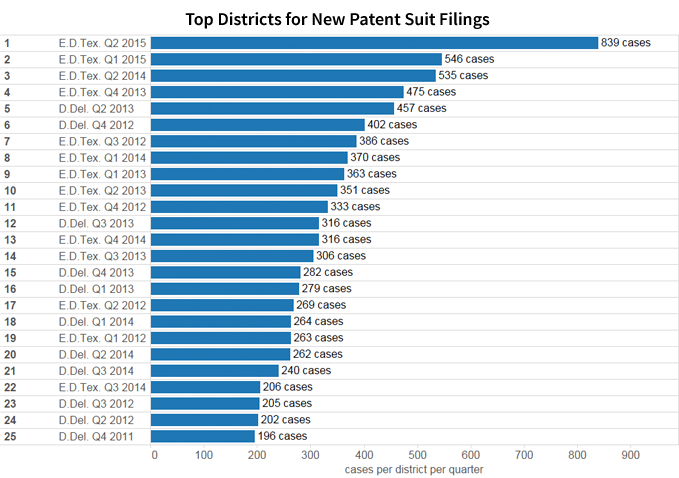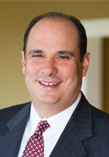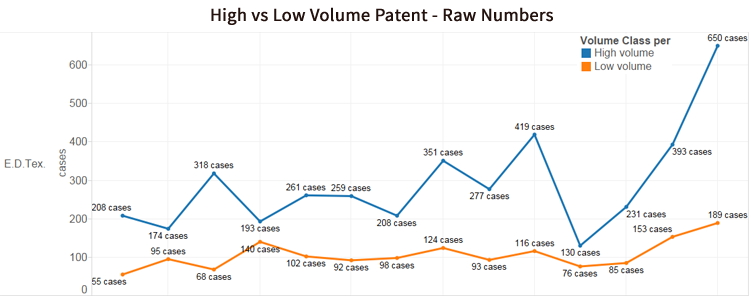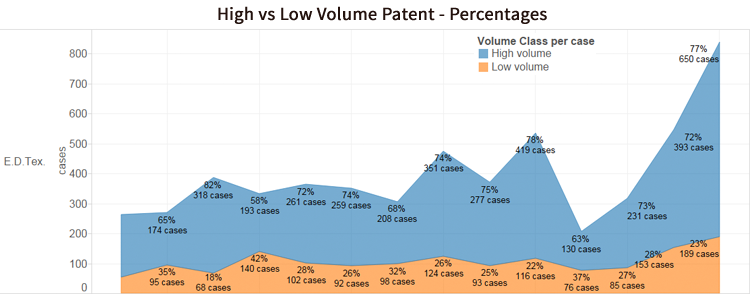© 2015 The Texas Lawbook.
By Jeff Bounds
(Aug. 13) – Patent holders flooded East Texas federal courts with an unprecedented number of new infringement lawsuits during the first six months of 2015.
In fact, there were more lawsuits alleging patent violations filed in the Tyler-based federal courts during the second quarter of the year than in all the other federal courts across the country combined.
Between April and June, lawyers shattered all records when they filed 839 new patent infringement cases in the Eastern District of Texas – a 53.6 percent increase from the 546 lawsuits filed during the first three months of 2015, which was the previous record for a single three-month period, according to Lex Machina, a California-based supplier of data about intellectual property litigation.
Nationwide, a record 1,656 new lawsuits alleging patent encroachment were filed nationwide during the second quarter of 2015 – half of those in East Texas federal courts.
Intellectual property law experts cite patent holders’ fear that Congress will pass new laws limiting the locations where they can sue infringers and a decision by many IP lawyers to stop filing their cases in Delaware because of recently enacted court rules they view as negative.

“My guess is that, rightly or wrongly, (plaintiffs) have read the tea leaves,” said Lex Machina Chief Evangelist and General Counsel Owen Byrd. “The patent owners and their counsel have the perception that they will get a better shake in the Eastern District.”
To put the Eastern District’s 839 new patent lawsuits during he second quarter into perspective, there were only 21 new infringement cases filed in the Northern District during the same time period, which was an increase from 18 new lawsuits filed a year earlier.
Leading the stampede into the district were what Lex Machina calls “high volume plaintiffs,” or patent owners that file more than 10 cases in a calendar year.
High volume plaintiffs accounted for 650 new patent cases in the Eastern District in the April to June period, or 77 percent of the new caseload.
“It is likely that a lot of patent infringement plaintiffs made their way to the courthouse in the second quarter based on fears associated with the so-called ‘Innovation Act” sponsored by Rep. Bob Goodlatte (R-Va.),” said Jason Cassady, principal at Caldwell Cassady & Curry in Dallas.

High volume plaintiffs are often – but not always – businesses that make money exclusively by wringing licensing fees and settlements out of businesses that may infringe the patents those plaintiffs control. This group of IP owners prefers to call themselves “patent assertion entities,” although defendants prefer the pejorative term “trolls.”
Regardless of the label, these operations are squarely in the crosshairs of legislative proposals, such as Goodlatte’s, that seek to curb some of their business and litigation tactics.
“One of the major issues that Congress debated regarding patent reform was where lawsuits could be filed,” said Jamil Alibhai, a Partner and Chair of the Litigation Section at Dallas-based Munck Wilson Mandala.
“One proposal would have removed the Eastern District of Texas because patent cases would generally be filed only where the defendant has its principal place of business or where the defendant has a physical presence.”
That would rule out most defendants from facing patent litigation in the Eastern District, he added. “As a result, plaintiffs filed more cases in the Eastern District prior to any change in the law regarding where patent cases could be filed.”

“The judges have experience in high volume litigation, and are able to move cases to trial,” he said. “The judges’ capability to keep these cases moving is a reason (plaintiffs) go there.”
Leaving Delaware for Texas
The surge in Eastern District filings of new cases has apparently come at the expense of the District of Delaware, which for years has been the No. 2 venue for patent litigation.
Delaware saw only 101 new patent cases in the second quarter, with a mere six of those coming from high volume plaintiffs, Lex Machina data show.
That is in line with a steady downward trend for that district. As recently as the second quarter of 2013, Delaware led the country with 457 new patent lawsuits, still the fifth-highest quarterly total for any district since the year 2000.
At that point, roughly 68 percent of Delaware’s new patent caseload came via high-volume plaintiffs, Lex Machina data show.
“It may be due to the new scheduling order and patent procedures implemented by some judges in (Delaware) to curb litigation abuse and streamline patent litigation,” said Tyler T. VanHoutan, a Houston-based Partner at Winston & Strawn.
At one point, plaintiffs began to see slowdowns in the pace at which cases were tried in Delaware, according to David Levy, partner and head of the Houston litigation practice group at Morgan Lewis.

A key change in Delaware is that judges can schedule early hearings to determine as a matter of law the meaning of words in patent claims.
Known as “claim construction” or “Markman” hearings, these pre-trial sessions are key in patent cases, because the definitions of a patent’s words are big elements in juries’ decisions on whether a defendant has infringed a patented invention.
Plaintiffs may view Delaware’s early Markman hearings as a negative in terms of getting defendants to settle cases there, VanHoutan said. The Eastern District, he noted, generally holds claim construction hearings after the parties have done a large amount of pre-trial exchanging of information, called discovery.
“While the Eastern District of Texas may not be the ‘rocket docket’ it once was, and even though the size of jury verdicts has generally declined in recent years, the Eastern District of Texas still boasts an environment that is very friendly towards plaintiffs,” he said.


Speedy Cases, Adept Judges
A number of factors make the Eastern District attractive to patent plaintiffs, according to Terrell R. Miller, a Partner at Gardere Wynne Sewell who spreads his time between Dallas and Houston.
Those factors include various practice rules the Eastern District has for patent cases, along with the relative certainty of which judge will handle a case based on which Eastern District division the plaintiff files suit in, he said. The district also has a reputation, fairly or not, as being plaintiff-friendly, Miller noted.
These variables “can add to the fear that smaller clients feel when sued in a jurisdiction that is not necessarily local to them,” he said.
Making things tougher, VanHoutan added, is the difficulty defendants have historically had in getting cases transferred out of the Eastern District.
The District also permits a broad scope of discovery. That “can make litigating cases very expensive, especially for large corporate defendants with massive amounts of relevant electronic documents,” he said.
In addition, defendants have had trouble securing wholesale defeats of patent suits prior to trial in the Eastern District – another boost to the cost of trying cases there, he said.
Plaintiffs, meanwhile, have found that Eastern District cases are getting to trial faster this year, according to Levy of Morgan Lewis.
“The quicker plaintiffs can get to trial, the better it generally is for the plaintiff,” he said. So “it should be no surprise that the pendulum swung back in favor of the Eastern District of Texas.”
One lure of the Eastern District for many patent plaintiffs is Judge Rodney Gilstrap, who is renowned for his ability to get cases concluded quickly.

Working out of Marshal, Judge Gilstrap “schedules trials early in the process, and is firm on those trial dates,” Jeang said. “He sets five cases for trial each given month, so that there is always a trial taking place in his court, even if many cases settle. He also actively urges the parties to settle. These factors are advantageous to plaintiffs that want to exert pressure on the defendants.”
© 2015 The Texas Lawbook. Content of The Texas Lawbook is controlled and protected by specific licensing agreements with our subscribers and under federal copyright laws. Any distribution of this content without the consent of The Texas Lawbook is prohibited.
If you see any inaccuracy in any article in The Texas Lawbook, please contact us. Our goal is content that is 100% true and accurate. Thank you.
